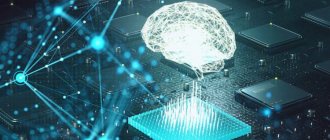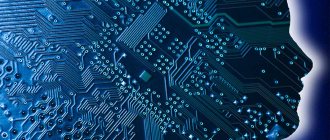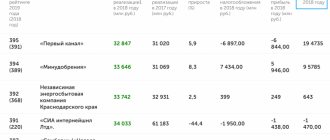1K 10 min.
In the 1950s and 1960s, when the first computers began to appear in large companies, scientists tried to model the structure of the brain using artificial intelligence (AI) algorithms. But they started talking seriously about the possibilities of AI only towards the end of the 20th century, when Garry Kasparov lost in chess to the IBM Big Blue supercomputer in 1997.
Neuromorphic platform Pohoiki Springs with 100 million neurons
Photo: Walden Kirsch/Intel Corporation
Neuromorphic platform Pohoiki Springs with 100 million neurons
Photo: Walden Kirsch/Intel Corporation
Significant changes occurred in the 2010s, when AI based on neural networks was trained to draw conclusions based on data analysis after preliminary “training”. Today, such systems are used, for example, to count passengers on a bus or record the license plate number of a traffic violator. Even smartphones eventually acquired AI - for example, for image or video processing.
According to IDC forecasts, the revenue of the global AI technology market, including programs, equipment and services, will reach $327.5 billion at the end of 2021, and will already exceed $500 billion in 2024. In Russia, IDC analysts estimated the AI market at the end of 2022 at $291 million
Modern AI technologies are progressing at great speed, but are still significantly inferior to “natural” intelligence: the human brain is more universal, better trainable, more flexible in analyzing and making decisions based on scattered and incomplete information, and also consumes significantly less energy.
The next generation of AI technologies, which, in particular, is being worked on at Intel Labs (the company's research division that studies promising ideas for working with data), will use algorithms that more accurately imitate the work of the biological brain, including in terms of interpretation (interpretation). in the right context) and autonomous adaptation (improved representation of data without interaction with the external environment) to respond to unexpected situations and various abstractions.
Neuromorphic computing based on digital neurons used for these purposes fairly accurately models the behavior of its biological counterparts. Together with probabilistic algorithms for processing uncertain and contradictory data, they are one of the most promising options for the development of AI. Today, neuromorphic computing is still at the research stage, but it is predicted to have a great future. For example, according to the forecast of i-Micronews, in the USA alone this market is expected to grow from $69 million in 2024 to $5 billion in 2029 and $21.3 billion by 2034.
What is artificial intelligence
Artificial intelligence in a broad sense is a branch of science aimed at developing analytical systems capable of learning and solving complex problems. In a narrow sense, these are technologies based on teaching a computer to human thinking.
Our brain works through the complex interaction of billions of neurons; artificial neural networks are created using this analogy. AI-based computer systems are capable of understanding and synthesizing speech, making decisions and acting. But artificial intelligence does not just execute given algorithms, but learns as information becomes available.
AI technologies are used in modern smartphones, in the design of smart homes, in medicine, education and various areas of business. But these technologies cannot fully replace humans: AI does not have the same multitasking capabilities that the human mind is capable of.
Another important difference between AI and natural intelligence is that human thinking is always associated with personality traits and emotions. Decisions and actions of computer networks do not have any emotional overtones and are based only on the results of information processing.
How neuromorphic computing works
Compact neuromorphic Kapoho Bay USB system with 262 thousand neurons
Photo: Walden Kirsch/Intel Corporation
Compact neuromorphic Kapoho Bay USB system with 262 thousand neurons
Photo: Walden Kirsch/Intel Corporation
Today, to accelerate AI, individual chips or processor modules are used, chips for deep machine learning or individual functions - for example, for computer vision, as well as video cards, the architecture of which, in particular, copes with parallel calculations better than central processors.
All these examples are far from neuromorphic computing, since they are built on a traditional von Neumann serial computing architecture with a separated processor and memory. Brain neurons, in turn, are capable of both storing and processing information.
Neuromorphic processors, created at the intersection of biology, physics, mathematics, computer science and semiconductor manufacturing, are built from familiar transistors, but with a different architectural organization, similar to the structure of neurons in a biological brain. By analogy with a biological sample, an artificial neuron has one output (axon), the signal from which can be sent to a large number of inputs of other neurons and thereby change their state.
Artificial neurons are combined according to the model of spiking neural networks (SNN), the peculiarity of which is the transmission of data using short pulses of equal amplitude spaced apart in time, and not due to time-varying values, as in neural networks of previous generations. By encoding data in pulses and time intervals between them, spiking neural networks model natural signaling processes that also drive learning processes with dynamic remapping of synapses between neurons in response to stimuli.
Types of AI
There are 4 main types of artificial intelligence:
- Weak AI.
This is the main type of AI today. It is not able to accumulate and use experience, it is created for one task and cannot perform additional functions. An example of this type of artificial intelligence is the online fraud protection system Fraud Detector. The program instantly identifies suspicious user actions on the websites of banks and online stores.
- AI with limited memory.
Able to remember fragments of data and analyze the current situation based on them. The accumulated experience is not stored in memory and is not compiled with other information. An example of such AI is self-driving cars. It monitors the speed and direction of movement of other cars over a certain period of time in order to make a decision about changing lanes.
- Strong AI.
Such machines must capture people's thoughts and motives, and have social and emotional intelligence to interact with humans. But strong AIs do not yet exist in reality, only in movies, for example, in Star Wars. But there is already a similar version of them - virtual assistants Siri and Alice, who are taught human communication patterns.
- Superintelligence.
The final stage in the development of artificial intelligence, which will be able to surpass humans in all aspects. The emergence of systems of this level will become possible when scientists fully study and model the system of functioning of the human mind.
Research directions
Philosophers have not yet come to a consensus about what the nature of human intelligence is and what its status is. In this regard, in scientific works devoted to AI, there are many ideas that tell what problems artificial intelligence solves. There is also no common understanding of the question of what kind of machine can be considered intelligent.
Today, the development of artificial intelligence technologies goes in two directions:
- Descending (semiotic). It involves the development of new systems and knowledge bases that simulate high-level mental processes such as speech, expression of emotions and thinking.
- Ascending (biological). This approach involves conducting research in the field of neural networks, through which models of intelligent behavior are created from the point of view of biological processes. Neurocomputers are being created on the basis of this direction.
How artificial intelligence works
To better understand the work of artificial intelligence, it is worth understanding its technologies:
- Machine learning.
The branch of AI science that deals with computers performing tasks independently. Machine learning systems are capable of processing large amounts of information, independently recognizing patterns and making predictions. They are used in areas where it is necessary to draw conclusions based on a huge amount of data: face, speech and object recognition.
- Deep learning.
This is a type of machine learning for solving problems based on pre-prepared data. To do this, it is necessary to provide a large array of initial information and configure a huge number of parameters for its correct processing. Deep learning networks are used in search engines, to recognize handwritten text and images, and detect fraud and spam. The most popular deep learning method is artificial neural networks. They are very similar to the principle of the brain: they process incoming signals and convert them into data to solve assigned problems.
- Synthesized speech.
The ability of a computer to understand and generate human speech is used to create virtual assistants (Google Assistant, Alice, Siri), business automation (telephony, analytics systems), and in medicine (data entry into electronic patient records).
Brain model
Neuromorphic (from the Greek νεῦϱον - fiber, nerve, and μοϱφή - form) computing uses neural network architectures, which, by analogy with biological nerve cells of the brain - neurons, exchange information with thousands of other neurons using synapses. The number of neurons is not a metric of such characteristics as brain, they largely depend on its organization (architecture).
For example, pigs and dogs have more than 2 billion, and a bear has about 10 billion neurons. The adult brain contains more than 85 billion neurons; the cerebral cortex, which is responsible for consciousness and intelligence, contains about 20% of all neurons. To model the operation of individual functions, a neuromorphic processor requires a significantly smaller number of neurons than for a complete brain model. The SNN class neural network provides extremely high speed and performance, and its structure can be trained directly during operation. It can handle dynamic tasks - for example, recognizing smells, speech or images in a video sequence. The multitasking of spiking neural networks makes it possible to train groups of neurons to solve various problems and perform predictive recognition from incomplete data.
Currently, many scientific groups and companies around the world are studying the use of impulse neural networks for modeling brain functions. Intel Corporation, together with an ecosystem of partners, solves problems in the field of neuromorphic computing in a comprehensive manner - from fundamental theoretical developments and the creation of algorithms to the development and production of neuromorphic processors.
Areas of use of artificial intelligence in business
AI is becoming increasingly widespread in various areas of business. Computer vision and facial recognition systems help companies solve several problems at once. For example, smart video surveillance can detect attempted thefts and reduce losses from theft of goods by customers.
Speech recognition technology enables the development of digital products for marketers. For example, chat bots, voice assistants, spam filters and systems for working with customer requests and reviews. Speech recognition systems save operators time on processing standard requests and help improve service. For example, MANGO OFFICE speech analytics monitors compliance with conversation scripts, identifies the most frequent customer requests, and tracks mentions of competitors.
Let's look at an example of how I transferred frequent questions to a contact center to a robot and saved my budget. The system, based on artificial intelligence, determined the purpose of the client’s request, sent non-standard questions to operators, and answered standard questions independently. The company managed to automate 250,000 calls and save 500,000 rubles per month on operator salaries.
Another direction of AI in business is unmanned vehicles. Yandex is testing robot couriers that are relevant in modern realities in one of the districts of Moscow. Autonomous special equipment for off-road driving or inside any closed systems (factory, park, airport) may soon appear.
What if we don’t destroy the world?
The alternative to teaching AI some ethics and telling it not to destroy the world—something the researchers say no algorithm can be absolutely sure of—is to limit the capabilities of superintelligence . For example, it may be disconnected from certain parts of the Internet or from certain networks.
But another recent study rejects this idea, suggesting that artificial intelligence is limited in its capabilities. This argument states that if we are not going to use AI to solve problems beyond human capabilities, then why create it at all?
If we want to build a future in which AI systems will be present, we may not even know when superintelligence will appear, which is beyond our control , such is its incomprehensibility. And as we strive to create superintelligence, the time has come to ask serious questions about the directions in which the development of these technologies is moving.
Technologies can be used both for the benefit of people and vice versa. Let's not forget this
A super-intelligent machine that rules the world sounds like science fiction, says Manuel Cebrian of the Max Planck Institute for Human Development. But there are already machines today that perform certain important tasks on their own, without the programmers fully understanding how they learned to do it.
So the question arises - and quite rightly - could AI at some point become uncontrollable and dangerous to humanity? Elon Musk, for example, like British theoretical physicist Stephen Hawking, believes so. What do you think about this? We will wait for the answer here, as well as in the comments to this article!
Artificial Intelligence Technology Market
In 2022, the revenue of Russian companies using AI technologies amounted to 291 billion rubles. This is data from 480 organizations, and the leaders among them are Yandex, Kaspersky Lab and Jet Infosystems JSC. The Ministry of Digital Development, Communications and Mass Communications predicts the Russian AI market will grow 80 times by 2024.
This rate of technology development will inevitably affect the labor market. A large number of routine tasks will be taken over by computers, which will lead to job cuts. On the other hand, there will be a need for professionals in the field of artificial intelligence: machine learning specialists, system operators, automation architects, authors of texts for interfaces and bots, lawyers in the field of intellectual property law.
Application of AI in modern life
Depending on the area and scope of application, there are two types of AI – Weak AI, also called “weak”, and Strong AI, “strong”. In the first case, the system is given highly specialized tasks - diagnostics in medicine, control of robots, work on the basis of electronic trading platforms. The second implies the solution of global problems.
Thus, one of the most popular areas of application of AI is Big Data in commerce. Large trading platforms use similar technologies to study consumer behavior. generally creates music with their help. Some mobile applications have built-in voice assistants like Siri, Alice or Cortana. They simplify the process of navigating and making purchases in the service. And don’t forget about programs with neural networks that process photos and videos.
AI is also being introduced into production processes to record worker actions. It was not without the introduction of new technological solutions in the transport sector. Thus, artificial intelligence monitors the condition of the roads, records traffic jams, and detects various objects in the wrong places. And they constantly talk about autonomous (unmanned) driving...
Luxury brands are incorporating AI into their systems to analyze customer needs. The use of such systems in healthcare systems is rapidly developing, mainly in diagnosing diseases, developing drugs, creating health insurance, conducting clinical trials, and so on.
It is almost impossible to list all the areas in which artificial intelligence is involved at once. At the moment, it affects more and more different areas. And there are many reasons for this - the same automation of production processes, the rapid growth of information circulation and investment in this area, even social pressure.
AI problems
Despite the rapid growth of technology, a number of problems arise associated with the development of artificial intelligence:
- The essence of artificial intelligence is working with huge amounts of data. If the source information contains inaccuracies or errors, this will affect the final result.
- AI programs are highly specialized and are not currently capable of multitasking like humans.
- The operation of smart systems requires serious financial resources. Only highly qualified specialists can service and configure them; the equipment also costs a lot.
Agent-based approach
It uses intelligent agents. This approach assumes the following: intelligence is the computational part through which goals are achieved. The machine plays the role of an intelligent agent. It understands the environment using special sensors and interacts with it through mechanical parts.
The agent-based approach focuses on developing algorithms and methods that allow machines to remain functional in a variety of situations.
Place of work and demand for specialists
AI specialist is the profession of the future, since the technology can find applications in many areas.
Let's list the industries in which AI developers are most in demand:
- Banks, financial, brokerage companies, hedge funds - for scoring systems, developing individual offers, risk assessment, tracking questionable transactions, etc.
- Medicine, healthcare - to monitor the increase in morbidity, test new drugs, clarify diagnoses, scientific research, etc.
- Retail, online sales, services for ordering goods or services and other areas related to big data analytics of Internet users.
- Transport, logistics, warehouse organizations, taxi services - to forecast demand and load, build optimal routes, etc.
- Information technology, telecom, development of computer games, programs for augmented and virtual reality, as well as robotics.
- Industrial and manufacturing enterprises, mining.
The profession is gaining popularity in Russia. The job search site Head Hunter currently has nearly 4,000 job openings that require knowledge of artificial intelligence. The most in demand are specialists with 1-3 years of experience in Moscow, St. Petersburg, Nizhny Novgorod, Novosibirsk and Krasnodar.
What you need to know to become an AI expert
To become an artificial intelligence specialist, you need to know at an in-depth level different branches of mathematics: probability theory, statistics, mathematical analysis and linear algebra.
The AI developer must also have the following knowledge and skills:
- Python programming language. Java or C/C++ can also be useful in your work.
- Popular Python frameworks for Data Science – Numpy, Pandas, Scikit-learn, Matpotlib.
- Tools for developing and training neural networks – Keras, Tensolflow, PyTorch.
- Databases and query language SQL.
- Algorithms for constructing recommender systems.
- Machine learning methods, computer vision technologies or natural language processing (NLP).
- Data visualization software, such as Tableau or Power BI.
- English for reading technical documentation.
How to learn a profession
You can obtain a profession as an artificial intelligence specialist either in a full-time university department or in an online school. Among the educational institutions where you can study to become an AI developer, we note:
- Moscow State Technical University named after N. E. Bauman.
- Russian Economic University named after G. V. Plekhanov.
- St. Petersburg State University of Aerospace Instrumentation.
- High School of Economics.
- Innopolis University.
Such faculties as “Intelligent Management and Data Processing Systems”, “Digital Economy and Big Data”, “Mathematical Methods of Artificial Intelligence” are suitable for this area. The specialty is prestigious, so the cost of study exceeds 100 thousand rubles per year.
A more convenient, effective and affordable learning format is online courses. You can master a profession remotely in up to 1.5 years. The curriculum contains a maximum of useful information and practice: homework after each lesson, team development, hackathons, etc.
Our website contains the best online courses on artificial intelligence. A convenient filter will help you find an option that suits your requirements: by price, term, availability of installments or discounts. Here you can find out the conditions of each training program, as well as read real reviews.
By the end of the course, you will have projects in your portfolio (for example, a neural network or a recommendation system), a diploma, and unlimited access to videos and other materials. Some schools offer internships and job placement assistance.











